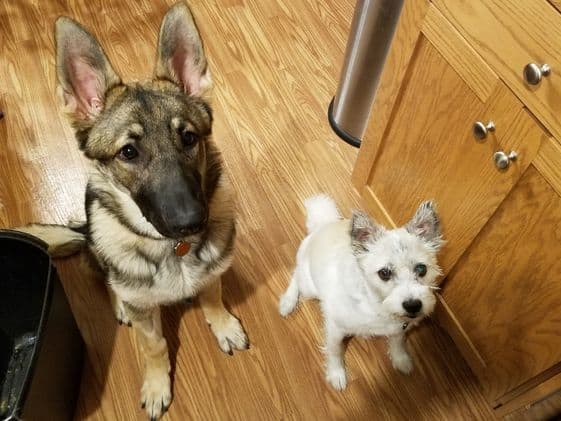One of the first things that a new puppy owner needs to do is teach their puppy its name.
This important step will be the foundation for all future commands, tricks, and training.
Teaching your dog its name is also a great way to bond with your pet, so it’s worth taking the time to get it right.
Here are some tips on how to choose an appropriate name, introduce it, increase difficulty when training, and avoid negative associations.

This post may contain affiliate links. That means if you click on them and buy something, I may receive a small commission at no cost to you. Read my Disclaimer Policy to learn more.
Why is Teaching My Dog Their Name so Important?

Teaching your dog their name is the basis of communication with them.
Once your dog knows their name, and you say it, they know that they need to listen to you.
It also aids in training as you can say “Luna sit” and they will know that you want them to sit, not someone else.
Though with my dogs, it doesn’t matter whether I say “Luna sit” or “Morgan sit” the result is usually the same.
They both sit.
I swear sometimes they think both of their names are Luna and Morgan, or LunaMorgan. 🤣
Choosing Your Puppy’s Name
The first step in teaching your puppy their name is to choose one!
Some people opt for traditional canine names like Max or Bella, while others prefer something more unique like Snuggles or Pickles.
There are a few things to keep in mind when you choose a name for your dog.
First, short names are easier for dogs to learn.
Try to choose a name that is no more than two syllables and easy to pronounce
Second, choose a name that doesn’t sound like other commonly used words like family names or a basic command like sit.
For example, “Bitsy” and “Kit” sound a lot like “sit” and “Wren” sounds like “Ben.” These names could lead to confusion for your dog.
Finally, try to pick something that doesn’t have any negative associations or would be embarrassing to say in public areas.
One of the steps I take when naming any of my pets is I imagine they got loose.
Would I be embarrassed to yell the name through the neighborhood looking for them?
If the answer is yes, then the name gets a no.
Ultimately, there is no “right name” for any dog.
But there is a perfect name for YOUR dog.
Just choose one that you are happy with and your dog will learn to respond to it.
Changing a Dog’s Name
Whether you get a shelter dog or a puppy from a breeder, they may already have a name.
If you don’t like the name the breeder or shelter gave your new dog, don’t worry, you can change it.
To change your new dog’s name, just follow the process of teaching a new puppy their name.
All the steps are the same.
Both Luna and Morgan came already named.
My family couldn’t agree on a new name for Morgan (it’s not easy getting 5 people to agree on one name), so we kept the name her foster home gave her when she was born.
When we got Luna, none of us really liked the name she had, so we changed it.
Some people recommend using the old name and new name together, but we didn’t do that.
We stopped using the name we didn’t like, and just didn’t use any name until we decided on the new name.
After a couple of days, we agreed on a new name and started using it right away.
Having a few days of no name and switching to using the new name only didn’t seem to have any effect on her learning her new name.
She started responding pretty quickly once we started teaching her the name.
Though, this may have been made easier by the fact that she was only 9 weeks old at the time.
I would imagine teaching an adult dog a new name might be harder as they are used to the name they already have.
But, at least around here, most shelter dogs are given a new name when they come in as they are strays with no known name.
So even the name they have at the shelter isn’t the name they are used to.
However, it could also be easier as adult dogs tend to have better attention spans than puppies do.
And if they already have some training, they understand the link between what you say and the treat much better than a puppy with no training.
How to Teach Your Puppy Their Name
Now that you know how to choose a name for your puppy, it’s time to start teaching them their new name.
To teach a dog their name you need to introduce the new name, practice using the name, and reward them for responding to the name.
Introduce Your Puppy’s New Name

The first thing you need to do to teach a dog their new name is to introduce it.
Choose a quiet room to start with as it will be easier for you to get your dog’s attention.
Start by saying the new name when your puppy is paying attention to you or looking at you.
Use a cheerful tone of voice when you say your dog’s new name and give them a tasty treat or lots of praise.
Using positive reinforcement consistently will help them make a positive association between the sound of their name and the treats or pets they get.
Play the Name Game
After introducing your puppy to their name, spend some time daily playing the name game.
The goal of the name game is to increase name recognition with your dog.
To play the name game you just say your puppy’s name, in a happy voice, and give them a small food reward when they look at you.
They don’t need to do anything other than look toward you, not even eye contact.
You are just looking for your dog’s attention when you say their name.
Play the name game a few times every day.
Just remember that a young puppy has a short attention span, so limit the game to a few minutes at a time.
Playing the name game helps your puppy learn that responding to their name means good things happen.
This will help them respond to their name whenever you use it going forward.
Increase the Difficulty
As your puppy starts to respond to their name when you use it, start increasing the difficulty of the name game.
Add in distractions.
Toss a ball right before saying their name.
Or show them a favorite toy.
If the distraction is too much, back it off a little and use something less distracting.
Also, start adding in some distance.
Instead of sitting right by your puppy, move a few feet away.
And finally, add in some time between saying the name and giving them the food treat.
Start with just a brief pause and slowly increase the time.
Then, start giving the treats randomly instead of every time they respond.
Use the Name Often
As your puppy learns their name, use it often, not just during training sessions.
Use it when you feed them.
When you take them potty.
When you play with them.
Whenever you have your puppy’s attention, use their name.
Use it throughout the day, especially with anything positive.
Just don’t use it when you are upset or for anything negative.
At this point, you only want them to associate good things with their name.
Practice Makes Perfect

Last, but certainly not least, practice makes perfect.
The more you use your puppy’s name and reward them for responding to it, the faster they will learn their name.
As you continue to practice their name, start practicing in new environments.
If you always practice in the living room, move to the kitchen.
And make sure to spend time practicing their name outside as well.
Outdoor practice will be the most difficult, so it is best to start it after you have a good response indoors.
For outdoor practice start in your backyard, then move to the front yard.
Eventually work up to going to the dog park, pet store, or other pet friendly locations.
Tips for Teaching Your Dog Their Name
Here are some tips for teaching your puppy their name.
Only Say the Name Once
Whenever you use your puppy’s name, whether playing the name game or using it throughout the day, only say it a single time.
Never say the name multiple times in a row to get your puppy’s attention.
If they don’t respond to the name, make some fun noises to get their attention.
If you start using the name more than once in a row your puppy may learn their name is Lunalunaluna instead of Luna.
Saying the name once and getting their attention in other ways will help prevent this.
Avoid a Negative Association with Their Name
When teaching your puppy their name, it’s important to avoid any negative associations.
This is to prevent them from not wanting to respond to their name.
This means that you should never use the name when scolding or disciplining them.
Instead, just use a firm “no” or “stop” and then redirect them to something constructive.
How Long Does it Take for a Puppy to Learn Their Name?
Generally speaking, puppies will learn their names within a few weeks of it being introduced to them.
However, this can vary depending on breed and individual temperaments.
Some puppies will start responding to their name within a few days and others may take up to a month or so.
If you feel like your puppy isn’t picking up on its new name after a few weeks, look at your training methods.
Are you practicing daily?
Is everyone in the household using the same name?
Nicknames are fine once your puppy is older and knows their name, but not until they know it and respond to it regularly.
Keep practicing and eventually, your puppy will know their name and respond to it reliably.
Related Posts
The First 10+ Things To Teach Your Puppy
How To Make Your Home Safe For A New Puppy
How To Survive The First 48 Hours With A New Puppy





